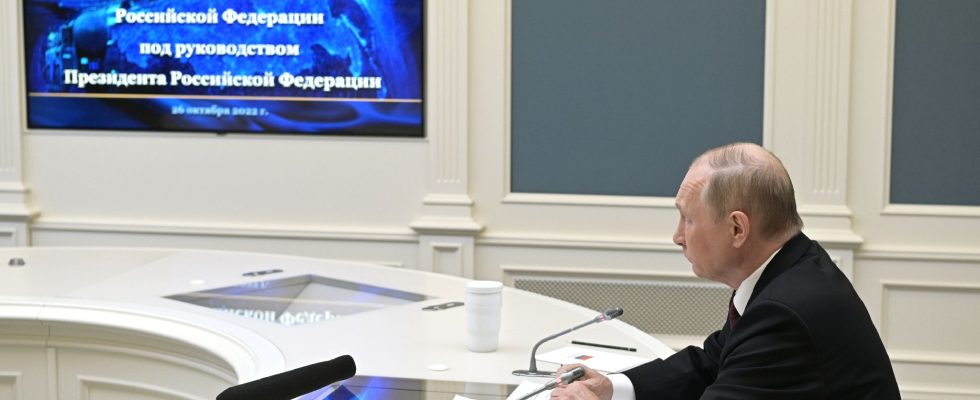Moscow could take another step backwards in nuclear disarmament. This Monday, October 9, the deputies of the lower house of the Russian Parliament of the Duma were to meet to discuss the exit from an international military treaty: the CTBT, or Comprehensive Nuclear Test Ban Treaty.
An agreement signed by the United States like Russia in 1996 at the United Nations and which aims to completely ban atomic explosions, including underground. This questioning in the Duma follows a statement by Vladimir Putin during a Russian international forum on October 5, estimating that such an exit could be a “symmetrical response” to the United States which has never ratified this treaty.
An approach which was then confirmed by Russian diplomat Mikhail Ulyanov in a message on X (formerly Twitter) published on October 6. If this exit from the CTBT remains to be confirmed, it would allow Russia to further justify its resumption of the development of nuclear weapons.
A treaty pending for 27 years
If Russia’s participation in this text is called into question, the CTBT is nevertheless still judged as “appropriate” by Vladimir Putin on October 5. Twenty-seven years ago, the Comprehensive Nuclear Test Ban Treaty was adopted by 185 countries under the auspices of the United Nations amid easing of Cold War tensions following the fall of the Soviet Union in 1991.
In 1996, this agreement then aimed to move towards “general and complete disarmament” of nuclear arsenals, clarifies its preamble, by imposing two obligations. First, that each signatory state stops and prevents in the future any “test explosion of nuclear weapons or other nuclear explosions” on the territories it controls. Then, he must refrain “from provoking or encouraging […] or participate in any way” in such a test. A way to prevent a nuclear power from helping an allied country develop its own H-bombs.
Thus, the CTBT aims to prevent Russia and other nuclear powers from regularly testing their warheads to be ready in the event of attack or defense, while freezing the number of countries concerned and the state of their atomic weapons technologies. . However, this treaty technically never came into effect : if the 44 states present at the time of the first negotiations were to sign then ratify the text, eight of them have still not validated this second stage. This is the case of China, India, Israel… and the United States. Russia ratified the CTBT in 2000, like France in 1998.
A withdrawal more symbolic than liberating
This is therefore the main reason put forward by Vladimir Putin today to justify Russia’s right to leave the agreement. In fact, this text nevertheless pushed many countries, including the United States, to establish a moratorium on nuclear tests following this text, specifies the British daily The Guardian. Likewise, Russia’s last nuclear test dates from 1990, 10 years before its ratification of the CTBT.
Therefore, leaving the treaty would not allow Russia to do anything that it cannot already do today. Breaking with this agreement would be rather symbolic: the CTBT has above all established a system of verification and global monitoring of nuclear tests, obliging the States which conduct them to take responsibility for them publicly. By distancing itself from this agreement, Moscow is therefore giving itself one more argument to explain the resumption of the development of its nuclear arsenal.
Although Russian diplomat Mikhail Ulyanov assures that “the revocation does not mean the intention to resume nuclear tests”, The Guardian recalls that the director of the main Russian research institute on atomic energy declared last week that the country could carry out a nuclear test “at least once” in the Russian Arctic archipelago of Novaya Zemlya in the future.
Tensions favoring a return to nuclear power
Moscow would not be the only nation to consider it: as reported CNNthe Californian Middlebury Institute of International Studies observed signs of activity at American and Chinese nuclear test sites at the end of September, in addition to confirming similar constructions in the Russian Arctic.
Signs which echo the increase in military tensions between these powers, in a context of Russian war against a Ukraine supported militarily by Western countries. To justify a possible exit from the CTBT, the president of the Duma also estimated that “the situation in the world has changed. Washington and Brussels have launched a war against our country. The current challenges require new solutions”, quotes the ‘AFP.
This text would also be the second international nuclear disarmament agreement that Russia would leave, after its withdrawal in February 2023 from the “New Start” treaty, which limited the number of nuclear warheads ready for use by Moscow and Washington since 2010. .
More than a desire for balance, the exit from the nuclear test ban treaty would therefore above all represent another threat to use this force in the long term, while Vladimir Putin has several times suggested that atomic weapons was not excluded in Ukraine if Russia felt threatened.
